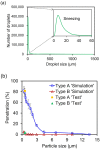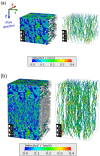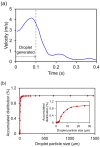Effects of the filter microstructure and ambient air condition on the aerodynamic dispersion of sneezing droplets: A multiscale and multiphysics simulation study
- PMID: 34335005
- PMCID: PMC8320464
- DOI: 10.1063/5.0053449
Effects of the filter microstructure and ambient air condition on the aerodynamic dispersion of sneezing droplets: A multiscale and multiphysics simulation study
Abstract
Concerns have been ramping up with regard to the propagation of infectious droplets due to the recent COVID-19 pandemic. The effects of filter microstructures and ambient air flows on droplet dispersion by sneezing are investigated by a fully coupled Eulerian-Lagrangian computational modeling with a micro-to-macroscale bridging approach. Materials that are commonly applied to face masks are modeled to generate two different virtual masks with various levels of filtration efficiency, and the leakage percentages through the unsealed nose and cheek areas were set to 11% and 25%, respectively. The droplet propagation distance was simulated with and without mask wearing in still and windy conditions involving head wind, tail wind, and side wind. The results demonstrate that wearing a face mask reduces the transmittance distance of droplets by about 90%-95% depending on the mask type; nonetheless, the droplets can be transmitted to distances of 20-25 cm in the forward direction even with mask-wearing. Thus, a social distance of at least 20 cm between people would help to prevent them from becoming exposed to ejected droplets. This study is significant in that important aspects of mask materials, in this case the porous microstructure-dependent filtration efficiency and permeability under varied ambient flow conditions, were considered for the first time in an evaluation of the barrier performance against droplet transmittance through a multiphase computational fluid dynamics simulation of air-droplet interaction and turbulence flow dynamics.
© 2021 Author(s).
Figures















Similar articles
-
On respiratory droplets and face masks.Phys Fluids (1994). 2020 Jun 1;32(6):063303. doi: 10.1063/5.0015044. Phys Fluids (1994). 2020. PMID: 32574231 Free PMC article.
-
Influence of wind and relative humidity on the social distancing effectiveness to prevent COVID-19 airborne transmission: A numerical study.J Aerosol Sci. 2020 Sep;147:105585. doi: 10.1016/j.jaerosci.2020.105585. Epub 2020 May 18. J Aerosol Sci. 2020. PMID: 32427227 Free PMC article.
-
Fundamental protective mechanisms of face masks against droplet infections.J Aerosol Sci. 2020 Oct;148:105617. doi: 10.1016/j.jaerosci.2020.105617. Epub 2020 Jun 28. J Aerosol Sci. 2020. PMID: 32834103 Free PMC article.
-
Effectiveness of face masks for the population.Ann Ig. 2021 Jul-Aug;33(4):347-359. doi: 10.7416/ai.2020.2390. Epub 2020 Dec 3. Ann Ig. 2021. PMID: 33258868 Review.
-
[Use of masks by children to prevent infection with SARS-CoV-2].Monatsschr Kinderheilkd. 2021;169(1):52-56. doi: 10.1007/s00112-020-01090-9. Epub 2020 Dec 18. Monatsschr Kinderheilkd. 2021. PMID: 33353989 Free PMC article. Review. German.
Cited by
-
Boundary conditions for exhaled airflow from a cough with a surgical or N95 mask.Indoor Air. 2022 Aug;32(8):e13088. doi: 10.1111/ina.13088. Indoor Air. 2022. PMID: 36040272 Free PMC article.
-
The effect of relative air humidity on the evaporation timescales of a human sneeze.AIP Adv. 2022 Jul 7;12(7):075210. doi: 10.1063/5.0102078. eCollection 2022 Jul. AIP Adv. 2022. PMID: 35989720 Free PMC article.
-
Numerical evaluation of face masks for prevention of COVID-19 airborne transmission.Environ Sci Pollut Res Int. 2022 Jun;29(29):44939-44953. doi: 10.1007/s11356-022-18587-3. Epub 2022 Feb 9. Environ Sci Pollut Res Int. 2022. PMID: 35141824 Free PMC article.
-
Tetrazolium-Based Visually Indicating Bacteria Sensor for Colorimetric Detection of Point of Contamination.ACS Appl Mater Interfaces. 2022 Aug 24;14(33):38153-38161. doi: 10.1021/acsami.2c08613. Epub 2022 Aug 10. ACS Appl Mater Interfaces. 2022. PMID: 35946791 Free PMC article.
-
Understanding lifetime and dispersion of cough-emitted droplets in air.Indoor Built Environ. 2023 Dec;32(10):1929-1948. doi: 10.1177/1420326X221098753. Epub 2022 May 18. Indoor Built Environ. 2023. PMID: 38023440 Free PMC article.
References
-
- Setti L., Passarini F., De Gennaro G., Barbieri P., Perrone M. G., Borelli M., Palmisani J., Di Gilio A., Piscitelli P., and Miani A., “ Airborne transmission route of COVID-19: Why 2 Meters/6 Feet of inter-personal distance could not be enough,” Int. J. Environ. Res. Public Health 17, 2932 (2020).10.3390/ijerph17082932 - DOI - PMC - PubMed
-
- World Health Organization (WHO), Health Topics: Coronavirus ( World Health Organization, 2021), see https://www.who.int/health-topics/coronavirus
LinkOut - more resources
Full Text Sources
